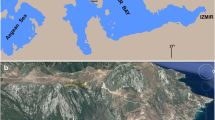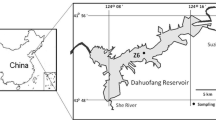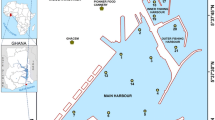Abstract
In Masan Bay, the drainage basin for the wastewater of heavily-industrialized cities and harbors in the southeastern Korea, a composite analysis of sediment cores reveals that accumulation history and behaviors of heavy metals are distinctive depending on anthropogenic activities and dissolved oxygen in water column. In the inner bay, Cu, Zn, and Pb have been enriched, associated with organic and sulfide matter, over background levels since the mid-1940s. It seems to result from the deposition of stream-disposed sewage under a poor water circulation before most of sewage collected in Masan City has been treated and disposed through an outfall into the outer bay since the late 1993. The outfall disposal contaminated the topmost sediments of the outer bay with the three metals, 2.2 to 3.2 times as much as the background. The three metals are strongly associated with Mn in the bay mouth, probably resulting from their oxidative precipitation beneath a chemical front of water column that forms by expansion and mixing of anoxic bay bottom water with oxygenated coastal water. The bay sediments seem to act as a mobile pool in that Mn and the pollutant metals are often remobilized to the anoxic bottom water in summer.
Similar content being viewed by others
References
Berner, R.A. and Raiswell, R., 1983, Burial of organic carbon and pyrite sulfur in sediment over Phanerozoic time: a new theory. Geochimica et Cosmochimica Acta 47, 855–862.
Calvert, S.E. and Pederson, T.F., 1993, Geochemistry of recent oxic and anoxic marine sediments: implications for the geological record. Marine Geology, 113, 67–88.
Cho, J.H., 2000, Fractionation and pollution history of heavy metals in Masan Bay sediments. Master's Thesis, pp. 88, Chungnam National Univ., Daejeon, Korea.
Elderfield, H., McCaffrey, R.J., Luedike, N., Bender, M. and Ruesdale, V.W., 1981, Chemical diagenesis in Narrangansett Bay sediments. American Journal of Science, 281, 1021–1055.
Emerson, S., Cranston, R.E. and Liss, P.S., 1979, Redox species in a reducing fjord: equilibrium and kinetic consideration. Deep-Sea Research, 26A, 859–878.
Gaillard, J.F., Jeandel, C., Michard, G., Nicolas, E. and Renard, D., 1986, Interstitial water chemistry of Villefranche Bay sediments: trace metal diagenesis. Marine Chemistry, 18, 233–247.
Goldberg, E.D., Gamble, E., Griffin, J.J. and Koide, M., 1977, Pollution history of Narragansett Bay as recorded in its sediments. Estuarine and Coastal Marine Science, 5, 549–561.
Grousset, F.E., Jouanneau, J.M., Castaing, P., Lavaux, G. and Latouche, C., 1999, A 70 year record of contamination from industrial activity along the Garonne River and its tributaries (SW France). Estuarine, Coastal and Shelf Science, 48, 401–414.
Harada, K. and Tsunogai, S., 1985, A practical method for simultaneous determination of234Th,226Ra,210Pb, and210Po in seawater. Journal of Oceanographical Society of Japan, 41, 98–104.
Hines, M.E., Bazylinski, D.A., Tugel, J.B. and Lyons, W.B., 1991, Anaerobic microbial geochemistry in sediments from two basins in the Gulf of Main: evidence for iron and manganese reduction. Estuarine, Coastal and Shelf Science, 32, 313–324.
Hong, G.H., Park, Y.A. and Lee, K.W., 1983, Partitioning of heavy metals in sediments from Jinhae Bay, Korea. Journal of Oceanological Society of Korea, 18, 180–184.
Hong, G.H., Kim, K.T., Pae, S.J., Kim, S.H. and Lee, S.H., 1991, Annual cycles of nutrients and dissolved oxygen in a nutrient-rich temperate coastal bay, Chinhae Bay, Korea, Journal of Oceanological Society of Korea, 26, 204–222.
Jacobs, L., Emerson, S. and Seki, J., 1985, Partitioning and transport of metal across the O2/H2S interface in a permanently anoxic basin: Framvaren Fjord, Norway. Geochimica et Cosmochimica Acta, 49, 1433–1444.
Jean, G.E. and Bancroft, G.M., 1986, Heavy metal adsorption by sulfide mineral surfaces. Geochimica et Cosmochimica Acta, 50, 1455–1463.
Kersten, M. and Forstner, U., 1986, Chemical fractionation of heavy metals in anoxic estuarine and coastal sediments. Water Science and Technology, 18, 121–130.
Kitano, Y., Sakata, M. and Matsumoto, E., 1980, Partitioning of heavy metals into mineral and organic fractions in a sediment core from Tokyo Bay. Geochimica et Cosmochimica Acta, 44, 1279–1285.
Kim, K.H., Cho, J.H. and Park, N.J., 2001, Distribution and pollution history of heavy metals in estuarine sediments of Nakdong River. The Sea. Journal of Oceanological Society of Koera, 5, 285–294.
Klinkhammer, G.P., Chin, C.S., Wilson, C., Rudnicki, M.D., and German, C.R., 1997, Distribution of dissolved manganese and fluorescent dissolved organic matter in the Columbia River estuary and plume as determined by in situ measurement. Marine Chemistry, 56, 1–14.
KORDI, 1981, A study on the system development for mentoring red tide bloom and pollution in Jinhae Bay, 265 pp.
KORDI, 1999, Development of the water quality management model in Chinhae-Masan Bay (II). 395 pp.
Kwon, Y.T. and Lee, C.W., 1998, Heavy metals contamination in coastal sediments by the large discharge from wastewater treatment plant. Journal of Korean Society of Marine Environment Engineering, 1(1), 83–92.
Lee, K.W., Lee, D.S., Lee, S.H. and Matsumoto, E., 1988, History of heavy metal pollution in Masan and Ulsan Bay sediments. Ocean Research, 10(1), 7–13.
Lee, S.H. and Lee, K.W., 1983, Heavy metals in sediments from Jinhae Bay, Korea. Journal of Oceanological Society of Korea, 18, 49–54.
Macdonald, R.W., Macdonald, D.M., O'Brien, M.C. and Gobeil, C., 1991, Accumulation of heavy metals (Pb, Zn, Cu, Cd), carbon and nitrogen in sediments from Strait of Georgia, B.C., Canada. Marine Chemistry, 34, 109–135.
Masan City, 1994, Monitoring of Masan Bay during sediment dredging (1990–1994). 264 pp.
Morse, J.W., 1994, Interactions of trace metals with authigenic sulfide minerals: implications for their bioavailability. Marine Chemistry, 46, 1–6.
Neumann, T., Christiansen, C., Clasen, S., Emeis, K.C., and Kunzendorf, K., 1997, Geochemical records of salt-water inflows into the deep basins of the Baltic Sea. Continental Shelf Research, 17(1), 95–115.
Ok, H.S., 1982, The study on the development history of Masan City. Geographic Society of Korea, 26, 15–51.
Olsen, C.R., Cutshall, N.H. and Larsen, I.L. 1982, Pollutant-particle associations and dynamics in coastal marine environments: a review. Marine Chemistry 11, 501–533.
Park, S.C. and Lee, K.W., 1996, Modern sedimentary environment of Jinhae Bay, SE Korea. Journal of Oceanological Society of Korea, 31, 43–54.
Rae, J.E. and Allen, J.R.L., 1993, The significance of organic matter degradation in the interpretation of historical pollution trends in depth profiles of estuarine sediment. Estuaries, 16 (3B), 678–682.
Ridgeway, I.M. and Price, N.B., 1987, Geochemical associations and post-depositional mobility of heavy metals in coastal sediments: Loch Etive, Scotland. Marine Chemistry, 21, 229–248.
Rumpel, C., Kogel-Knabner, I., Knicker, H. and Huttl, R.F., 2000, Composition and distribution of organic matter in physical fractions of a rehabilitated mine soil rich in lignite-derived carbon. Geoderma, 98, 177–192.
Shaw, T.J., Gieskes, J.M. and Jahnke, R.A., 1990, Early diagenesis in differing depositional environments: The response of transition metals in pore water. Geochimica et Cosmochimica Acta, 54, 1233–1246.
Skei, J.M., Loring, D.H. and Rantala, R.T., 1988, Partitioning and enrichment of trace metals in a sediment core from Framvaren, South Norway. Marine Chemistry, 23, 269–281.
Sorensen, J. and Jorgensen, B.B., 1987, Early diagenesis in sediments from Danish coastal waters: microbial activity and Mn−Fe−S geochemistry. Geochimica et Cosmochimica Acta, 51, 1583–1590.
Stein, R., Grobe, H. and Wahner, M., 1994. Organic carbon, carbonate, and clay mineral distributions in eastern central Arctic Ocean surface sediments. Marine Geology, 119, 269–285.
Sternbeck, J. and Sohlenius, G., 1997, Authigenic sulfide and carbonate mineral formation in Holocene sediments of the Baltic Sea. Chemical Geology, 135, 55–73.
Turekian, K.K. and Wedepohl, K.H., 1961, Distribution of the elements in some major units of the earth's crust. Bulletin of Geological Society of America, 72, 175–192.
Turner, A. and Millward, G.E., 2000, Particle dynamics and trace metal reactivity in estuarine plumes. Estuarine, Coastal and Shelf Science, 50, 761–774.
Valette-Silver, N.J., 1993, The use of sediment cores to reconstruct historical trends in contamination of estuarine and coastal sediments. Estuaries, 16(3B), 577–588.
Woo, H.J., Cho, J.H., Jeong, K.S., Chung, C.S., Kwon, S.J., and Park, S.M., 2003. Pollution history of the Masan bay, southeast Korea, from heavy metals and Foraminifera in the subsurface sediments. Journal of Korean Earth Science Society, 24(7), 635–649.
Yang, D.B. and Hong, G.H., 1982, Nutrients and Chlorophill a variations at a fixed station during the red tides in Jinhae Bay. Journal of Oceanological Society of Korea, 17, 19–26.
Yang, D.B., Kim S.H. and Lee, K.W., 1984, Vertical distribution of chemical oceanographic parameters in Jinhae Bay in July, 1983. Journal of Oceanological Society of Korea, 19(1), 89–93.
Yang, H.S. and Kim, S.S., 1994, Pollution of heavy metals and sedimentation rate in the sediments of Suyeong Bay, Pusan. Bulletin of Korean Fishery Society, 27(5) 643–658.
Yang, H.S., Kim, S.S. and Kim, G.B., 1995, Pollution of heavy metals and sedimentation rates in sediment cores from Chinhae Bay, Korea. Journal of Korean Environment Science Society, 4(5), 489–500.
Yu, H.S., Min, B.E. and Kim, C.J., 1985, Physical characteristics of circulation and mixing processes at the mouth of the Nakdong River. Maritime University Report, 2, 1–17.
Author information
Authors and Affiliations
Corresponding author
Rights and permissions
About this article
Cite this article
Jeong, K.S., Cho, J.H., Lee, J.H. et al. Accumulation history of anthropogenic heavy metals (Cu, Zn, and Pb) in Masan Bay sediments, southeastern Korea: A role of chemical front in the water column. Geosci J 10, 445–455 (2006). https://doi.org/10.1007/BF02910438
Received:
Accepted:
Issue Date:
DOI: https://doi.org/10.1007/BF02910438




